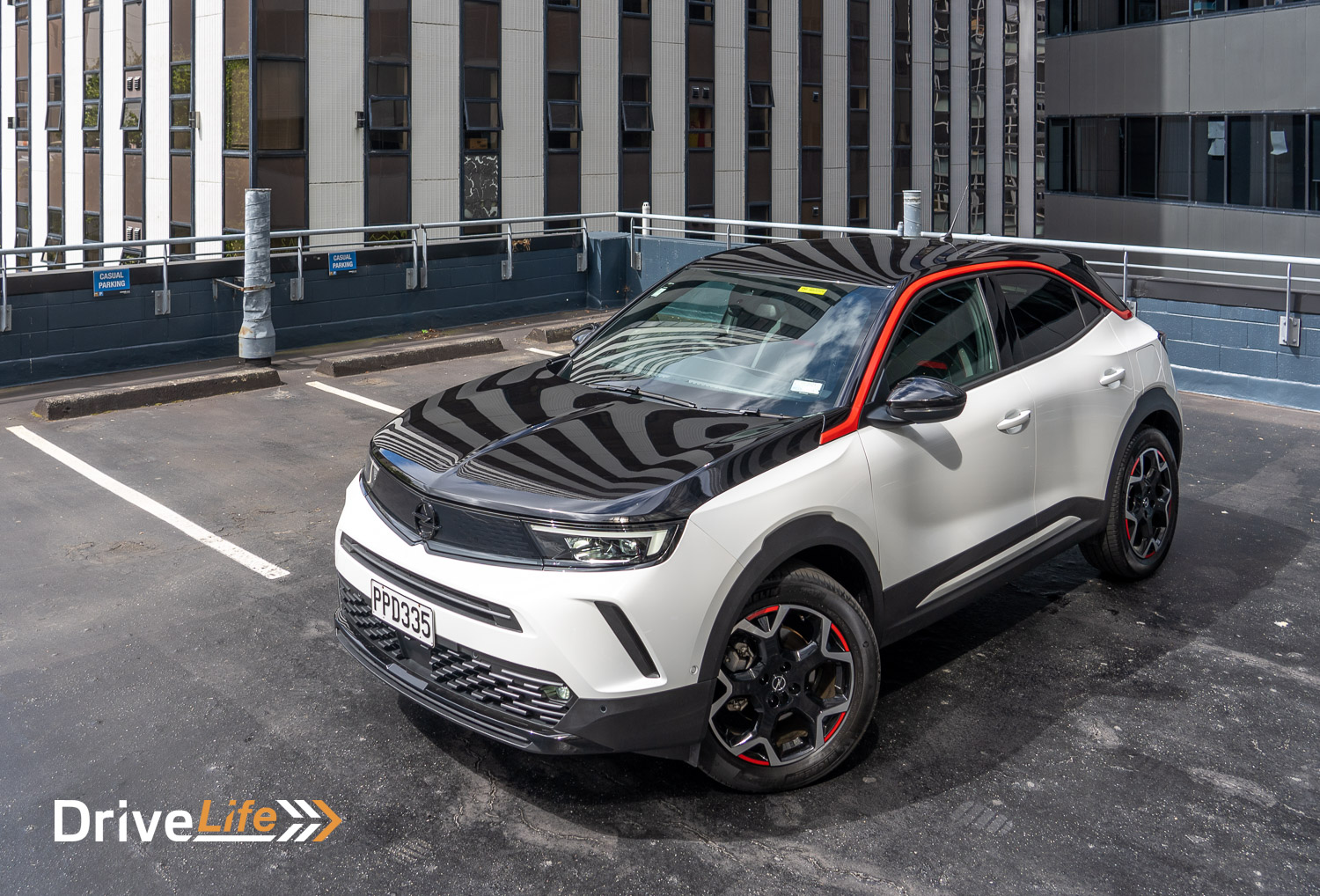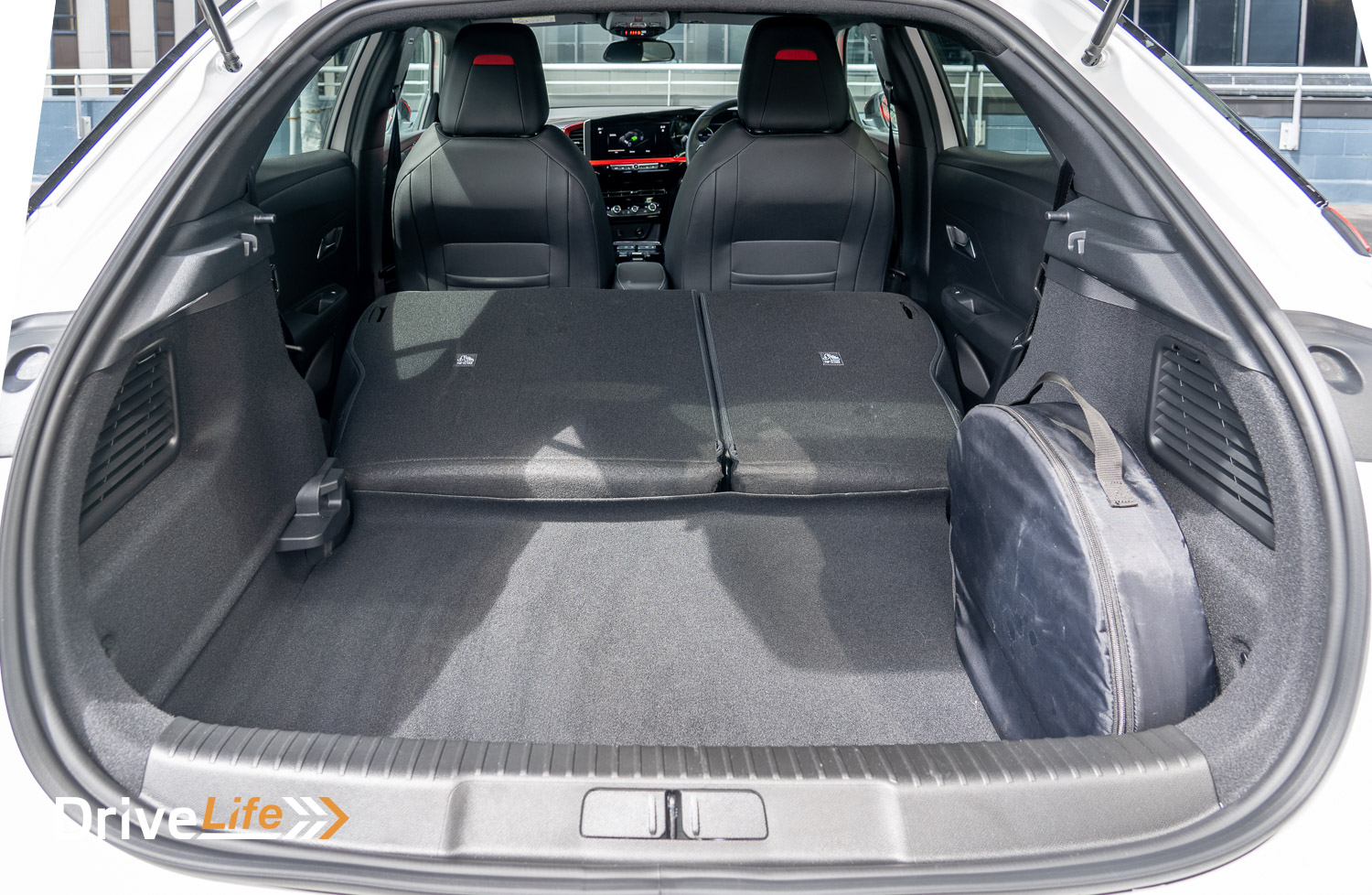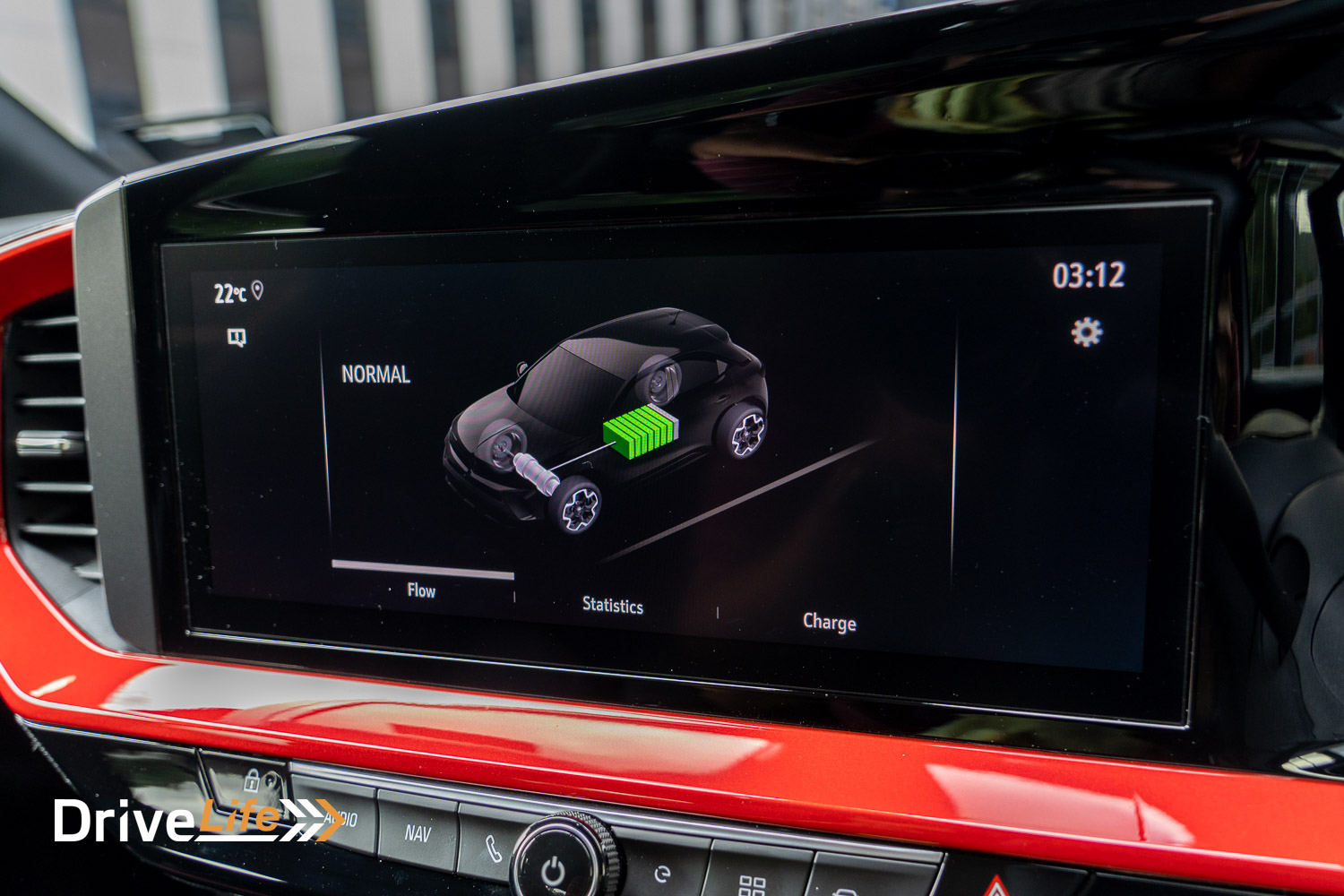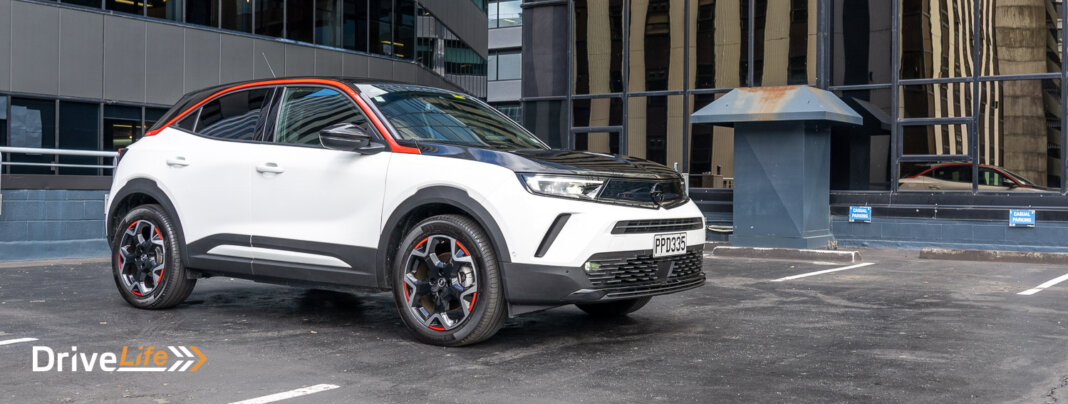As a brand, Opel made its return to New Zealand last year, promising a bunch of internal-combustion-engined (ICE) cars, as well as a good selection of battery-electric vehicles (BEVs).
At the launch, the Mokka-e was shown as the first offering to hit our shores, a full BEV with a range of around 320km. As part of our testing, we’ll spend 4 days commuting in the Mokka-e, then hit the road to Cambridge and back, another 1,000km added to our testing.
How much charging will we really need to do on an open-road trip in the Mokka-e? When we say we thoroughly test cars, we mean it. Join us for 1,500km of testing in the 2022 Opel Mokka-e.

What We Like and Dislike About The 2022 Opel Mokka-e SRi
| What we like | What we don’t like |
| Driving dynamics Refinement Design Physical controls (not all touchscreen) Seat comfort Energy economy Matrix LED headlights High-def dashboard Steering wheel controls Walk up lock/walk away unlock | Pricing Interior space Charging issues with our test car Lane Positioning Assist Audio reverts to radio |
What’s In The 2022 Opel Mokka Range?
You can pick from two petrol-engined Mokka’s, or just one EV, the Mokka-e SRi. The base model is the Edition, then there’s the SRi. These both run a 1.2-litre, turbocharged 3-cylinder motor that puts out 96kW of power and a great 230Nm of torque. Both are front-wheel drive and have an 8-speed automatic transmission.
Fuel consumption for the petrol-engined Mokkas is listed at 5.7L/100km.
For the EV model, Opel is only offering it in the top-spec SRi. This model has a 100kW electric motor driving the front wheels, and that motor outputs 260Nm of torque. The battery is a lithium-ion unit that has a capacity of 50kWh.
Opel suggests charging times of 28 hours from flat to full with a standard household power outlet, 7 hours with a 7.4kW wall box charger at home, or 30 minutes with a 50kW fast charger.
With that size battery and suggested energy consumption of 14.5kWh/100km, the Mokka-e is expected to drive around 363km on a single charge.

2022 Opel Mokka Standard Equipment Highlights
SAFETY AND SECURITY
- Hill Start Assist
- Six airbags
- Immobilsor
- Tyre Pressure Monitoring
- Cruise control and speed limiter
- Lane Keep Assist
- Traffic Sign Recognition
- Active Emergency Braking with pedestrian detection
- Blind Spot Monitoring
- 17” alloy wheels
LIGHTING AND VISIBILITY
- LED headlights
- Automatic high beams
- LED DRLs
- LED front fog lights
- LED rear lights
- Automatic windscreen wipers
- Welcome Home and Follow Me lighting
INTERIOR FEATURES
- 7” digital instrument cluster
- Heated flat-bottom steering wheel
- Paddle Shifters
- Heated front seats
- Climate AC
- Electrically heated and folding exterior mirrors
- Auto-dimming rearview mirror
- Electric park brake
- One-touch electric front windows
- Front and Rear Parking Sensors
- 180-degree reversing camera
- Keyless entry and start
- 7” centre touchscreen
- 6-speaker audio
- Apple CarPlay and Android Auto capability
Moving up to the SRi with a petrol engine or electric motor adds:
- 12” digital driver’s dashboard
- Alloy pedals
- Front and rear mats
- Black leatherette & cloth with red stitching
- 10” centre touchscreen with SatNav
- Adaptive Cruise Control
- Lane Positioning Assist
- Active Emergency Braking with night function, pedestrian and cyclist detection
- Matrix LED headlamps
- Black-painted bonnet
- Front and rear bumpers with black trim
- Overtinted rear windows
- 18” alloy wheels
2022 OPEL MOKKA – PRICING
- Edition; $38,990
- SRi; $44,990
- Mokka-e SRi; $69,990
Our Review Vehicle’s Optional Equipment
Since our test car was finished in Jade White, this added $550 to the cost to give it a total of $70,540.
2022 OPEL MOKKA – COLOURS
You get to pick from one of 6 colours for your Mokka, with just Matcha Green metallic coming in at no cost.
- Matcha Green (metallic)
- Power Red (metallic) $550
- Voltaic Blue (metallic) $550
- Diamond Black (metallic) $550
- Quartz Grey (metallic) $550
- Jade White (solid) $550
For a complete list of specs and options available for the Opel Mokka-e, head on over to the Opel New Zealand website.
How Does The 2022 Opel Mokka-e SRi Compare To Its Competition?
| Make/ Model | Battery Capacity kW-hr | Power/ Torque kW/Nm | Range, km (WLTP) | Boot Space, litres | Price (excl CCP) |
| Peugeot e-2008 | 50 | 100/260 | 372 | 434 | $75,990 |
| Mazda MX-30 EV | 35 | 107/271 | 199 | 341 | $74,990 |
| 2022 Opel Mokka-e | 50 | 100/260 | 363 | 310 | $69,990 |
| Hyundai Kona EV | 39 | 100/395 | 305 | 332 | $69,990 |
| MINI Cooper EV | 3 | 135/270 | 233 | 211 | $60,400 |
| BYD Atto3 Extended | 60 | 150/310 | 420 | 440 | $59,990 |
| MG ZS EV | 50 | 130/280 | 320 | 359 | $53,990 |
First Impressions Of The 2022 Opel Mokka-e SRi
A danger of building a car on the same platform as the funky Peugeot 208, is that there’s a chance you don’t pull off an equally appealing design. This hasn’t happened with the Mokka; it looks great.
Opel has really paid attention to the little things to give this car a personality, including the red trim running along the roof line, and some red flashes on the alloy wheels.

It’s nicely proportioned, looks fresh and fun, and is definitely appealing to the younger market that this model is aimed for. I think an example of this is when I was in Cambridge, parking the car in the hotel car park. Two young women in their early 20s stared at the car while I drove slowly past, and then watched as I parked. Perhaps they thought I was their Uber, but by the look on their faces, they very much enjoyed the design of the Mokka-e.

What’s The Interior Like In The 2022 Opel Mokka-e SRi?
With nice, wide-opening front doors, the cabin initially feels quite inviting, although there is a low roof line on the Mokka, so taller people will need to duck down some.
Some might feel the red trim in the cabin is a bit too much, but with an all-black interior, the red is refreshing and gives much-needed relief. There’s also red stitching on the front seats, and the seats have a grey edge, again helping to break up the black. It was interesting to see that at near-on $70K, the seats have no electric adjustment.

The dash and doors have carbon-fibre effect panels, and they don’t look too cheap or out of place at all. Sitting in the driver’s seat, the leather, flat-bottom steering wheel feels great to the touch. Like most newer Peugeot and Citroen models, instead of a gear lever, there’s a gear selector to put the car into Drive or Reverse. To put the car in Park, you’ll need to press the (small) P button to the right of the selector. It all becomes second nature very quickly, but how I wish that Park button was bigger.

Overall, the build quality is very good with nice, tight shut lines on the body, and the interior seems well put together. One caveat to this was the roof console in our test car; it had loosened off at the rear, flopping around slightly if you touched it.
Up front, there is a single USB-A port next to a 12-volt socket for your dashcam. There’s piano black around these, and lots more piano black on the centre console and on the dashboard. It does feel a bit too much of one finish in the cabin. At the rear of the console, there is a small cubby, big enough for a few wallets but not too much more. The lid on the cubby is a sliding one, very handy for those long road trips. As per Peugeot and Citroen models, the glovebox has a normal-width door but the usable size is around half of that.

The front doors have a soft leatherette finish above and below the door’s armrest, making the car feel a little more upmarket. Weirdly, the rear doors are all just solid plastic instead. Those rear doors open out as wide as the front ones, but they are smaller, and have a sticky-outy piece at the rear of the door, so best be careful getting in or out so you don’t hit your head on it.

Space for your rear-seat passengers is average for the class, with headroom being on the tighter side of things. While that funky design looks cool, the sloping rear roofline cuts into headspace some. Rear-seat passengers have access to two USB-A ports, although they don’t have any cup holders or a fold-down armrest. The windows in the rear doors go down just past halfway, again a result of a sexy, reducing roofline.

The boot is a double-height one, so you can move the floor panel up or down depending on what your storage needs are. There is no spare under the floor, just a pump and tyre repair kit. At 310 litres, the boot is reasonable for the size of the Mokka-e, and I certainly made the most of that on my road trip, filling it up to the level of the parcel tray cover.




What’s The 2022 Opel Mokka-e SRi Like To Drive?
Picking up the car at 100% charged showed 328km of range, with my first four days with the Mokka-e commuting. That commute is a 40km one-way journey, with a mix of suburban streets, then some city driving, then motorway, then rural. A great mix of roads, and it was excellent to see the Mokka-e return 14.1kWh/100km for that first day’s commute. That’s a great result and even better than the 14.5kWh/100km that Opel claims.
The Mokka-e shines when being used as a commuter; visibility is generally very good, although the C pillar is enormous and reminds me exactly of the Mazda3. Performance is reasonable, the controls are light and mostly easy to get to and use. Adaptive cruise control is standard, and it will bring the car to a stop. There’s a ‘MEM’ button too so if you pass a new speed limit sign, tapping the MEM button twice will set the cruise control to the new speed limit. It was good to see that traffic sign recognition on the Mokka-e was generally faultless.

You get to pick from three drive modes in the car; Eco, Normal, and Sport. The car won’t remember the last drive mode you selected, so if you want to drive in Eco mode all the time, you need to select it each time you start the car. Eco mode still has plenty of performance for everyday driving, and I often found myself selecting it when getting in to drive. When picking Eco mode, you get a dashboard warning that performance and thermal comfort will be limited, but honestly, I found little difference in either. Eco mode works very well in the Mokka-e.
Obviously, Normal drive mode will see a performance increase, and choosing Sport mode will see the car leap ahead slightly, perking up like a Meerkat. Sport mode will give the car something closer to the performance you would expect out of an EV, but let’s be honest, with 100kW of power it’s not going to be a rocket ship. We found the same, subdued performance in the Peugeot e-208 which has the same EV setup.
Unlike some other EVs with paddles to control your brake regeneration (regen), the Mokka-e has a small button on the console for this. Tapping that ‘B’ button will turn on the brake regen, but it’s not variable at all. It’s quite effective though – not quite one-pedal driving, but you can certainly feel the car slowing more when it’s turned on. It’s a great way to get some charge back into the batteries without applying the brakes until needed. Like the drive modes, the car won’t keep regen on each time you start it, you’ll need to turn it on yourself. It would be great to have this as an option.

A few days later and having driven 239km, I had 58km of range left giving an effective real-world Wellington range of around 300km. We’ve said time and again; Wellington’s hills are a massive test for any EV’s range. Time to charge up to 100% for our road trip to Cambridge tomorrow, around a 500km drive. I find it a little humorous that the Mokka-e has an arrow by the battery meter to show you which side the charger is on, but the charger is on the opposite side.
Hitting the road at 7 am, on Transmission Gully I am reminded of one superb feature of the Opel Mokka-e: driving refinement. There is almost zero wind noise, zero road noise, and tyre noise is very well suppressed. Regardless of it being an EV, motorway driving is a near-silent affair. This fact was repeated to me over and over during the next three days and 1,000km of driving and is absolutely a highlight of the car, and if I’m being honest, a surprising one at that.

Using Lane Positioning Assist in the Mokka-e is a variable affair; sometimes it’s perfect, maintaining a nice, straight course while it follows the lanes. At other times, it would heavily favour the centre line, or the fog line, or wander a bit in its lane while trying to make up its mind where it wanted to drive. I could almost pick the times when it would not work correctly, and sometimes even on perfectly painted and new lanes, it didn’t work that well. Still a handy safety feature but I was sure to keep my grip on the steering wheel at all times. You can turn it off by pressing the button on the console.
As the day heated up, I found one small issue with the aircon that may only relate to me. While the front-seat passenger has two air vents at face level, the driver’s left vent is down low on the centre of the dash, and it can’t direct cool air up to your left hand. I like to have some cool air on both hands while driving, so this wasn’t possible. There is space in the dash for a driver’s left-hand air vent, but for some reason, Opel decided to put it down low. Otherwise, the AC is near-on perfect. You get physical, actual buttons to control AC so there is no need to use the touchscreen to manage this. Let’s hope other manufacturers also revert to physical buttons rather than using touchscreens. It just works.

That centre touchscreen is listed at 10”, but like Peugeot and Citroens, a large portion of each side is taken up with things like AC displays. It reduces the size of the screen quite a bit and is noticeably small when using Apple CarPlay. The infotainment system is easy to use though, and quite responsive to your touch. Being an EV, hitting the EV button next to the volume knob will bring up a screen showing energy flow, charging options and some EV statistics.

So yes, there is also an actual volume knob – again, no need to use the touchscreen to adjust your volume. While the Mokka-e is targeting younger buyers, this was a welcome part of the car’s controls. Audio quality in the car is more than acceptable and should appease that younger market, with plenty of bass available. Painfully, every time you start the car the audio reverts to radio, so you’ll need to select Bluetooth every time you want to stream music from your phone, or plug it into the USB cable.
The driver gets some good dashboard options, and being a top-spec SRi model, that means a digital dashboard. There are seven distinctive dashboards to choose from; Energy Flow, Minimum, Personal, Navigation, Driving, Dials, and Computer (trip computer). In most of the screens, the digital speedo is nice and large, and in Minimum, it’s enormous. I’ve had a few cars lately with tiny digital speedos so this was a welcome change. The dashboard itself is very high resolution, as you can see below; it’s another feature of the Mokka-e that makes it a great commuter.







That flat-bottom steering wheel feels great to the touch and has prominent thumb grips to encourage use. The steering wheel controls are easy to use and quickly learnt. The cruise speed adjustment thumbwheel on the left side of the wheel and volume up/down adjustment on the right side are a highlight. They are rubberised and have a central ridge, so you can find each one very quickly without looking down, and a flip up or down is a brainless task. They work exactly as intended and make a mockery of other cars that use separate buttons for these functions.

On that long drive north, those and other controls of the Mokka-e gave me the feeling that while Opel is targetting the car to younger buyers (in its design, mostly), the car still feels analogue; Not old school in any way, but Opel has used controls (audio, AC, steering wheel) that are simple and effective. Other than the tiny P or B buttons on the console, everything else works brilliantly.
Well, maybe with one other exception. Again, I’m not sure why, but the engine start/stop button is hidden up under the left side of the steering wheel, and I struggled to find it every time. I’d almost always have to lean down to find it. Moving it to the centre console would have been easy to do and made it simple to find. Hopefully, we’ll see this in a future update. The other ‘glitch’ with the on/off button is that you have to hold it down for around 2 seconds to turn the car on, or off. This is the same on Peugeot and Citroen, and a bit of a pain when you’ve been driving other cars. I’ll admit that more than twice, I got out of the car and it wouldn’t lock, as I hadn’t held that button down for long enough. I realise this is by design and probably a safety feature, but it’s a little painful.

On a more positive note, the Mokka-e does walk-up unlock or walk-away lock, making daily use just that little bit easier. A small thing, but much appreciated.
That drive north showed up a characteristic of the Mokka-e’s donor car: a great ride. Regardless of the car being heavier than its petrol brother, the ride is excellent and was a pleasure to experience on that long road north.

As I drove north, I thought I might make it to Turangi to do my first charge, but it was obvious early on that I wasn’t going to make it that far. Waiourou was my next hope, but as I pulled into Taihape, I had 11km of range left. So Taihape it was; I pugged in and set the charger going, went and had lunch and did some work on the laptop. Fifty minutes later the coffee was gone and the car was at 80% charged. It was a pretty painless stop. That first drive on the open road from a full charge looks like it got me a real-world range of around 250km at a rate of 17.9kWh/100km.

Heading north again, I could tell I wouldn’t quite get to Cambridge, so decided to stop in at Taupo and use one of the Chargenet Hyperchargers, which pumps out 300kW of power. The Mokka-e can’t take that much power – only the Porsche Taycan can – but it would still be better than a 50kW charger. This is where I had issues with the Mokka-e; it refused to talk to the Hypercharger. A phone call to Chargenet, and they rebooted the Hypercharger and away the car went, charging at 70kW. I sat for just 15 minutes and got the car up to 200km of range, plenty to get to Cambridge.



After my weekend away, it was time to head back home again, after charging up at a BP fast charger in Cambridge. This charger did 80kW, so again, more powerful that the more common 50kW Chargenet chargers. I hit the road and managed to get to Turangi and spent 40 minutes getting the Mokka-e back to 80% full. Keep in mind you rarely charge to 100% on a fast charger, as that last 20% can take a very long time. Better to do little charges more often.
On the road again, I got to Mangaweka but decided that I could make it to Bulls to charge, with 20km or so range left. This wasn’t quite the case, as a headwind meant I pulled into Bulls with 1% charge remaining, and the turtle sign showing on the dashboard. While the car was in turtle mode, I couldn’t really feel any difference in performance as you do with other EVs if you get down that low.

I hooked up to the Chargenet Hyperchrger in Bulls, and no joy. The same scenario as in Taupo, the car wouldn’t talk to the charger. So I moved the car ten feet over to the 250kW charger, and had the same issue. Eventually, Chargenet rebooted the 250kW unit and got the Mokka-e charging up. Since I had no issues with BP or Z fast chargers, it seems like it is only the Chargenet Hypercharger that was having issues with our test car.

Twenty minutes later I had 200km of charge, plenty to get home with. Now pretty dark, a great feature of the Mokka-e came to light; its Matrix LED headlights. They are excellent, and the intelligence around managing the car on high beams while following other drivers was superb. Such a better way to drive at night.

Seat comfort on that long trip was excellent overall. The padding is quite firm but was fine for me. There is no lumbar adjustment on the seat at all, but after doing 500km in a day, I didn’t really miss it.
Over a total of 1,500km of driving the Opel Mokka-e, my energy economy was 16.5kWh/100km. Since a majority of my driving was on the open road, I think this is an excellent result.

2022 Opel Mokka-e SRi
| Vehicle Type | 5-door, small SUV |
| Starting Price | $69,990 |
| Price as Tested | $70,540 |
| Engine | 50kW electric motor, front-mounted |
| Power, Torque kW/Nm | 100/260 |
| Transmission | One-speed automatic |
| Spare Wheel | Pump and tyre repair kit only |
| Kerb Weight, Kg | 1,523 |
| Length x Width x Height mm | 1451x1791x1532 |
| Boot Space / Cargo Capacity, Litres (seats up/seats down) | 310/1,060 |
| Energy Economy, kWh/100km | Advertised Spec – Combined – 14.5 Real-World Test – Combined – 16.5 Low Usage: 6-10 / Medium Usage 11-19 / High Usage 19+ |
| Towing Capacity Kg, unbraked/braked | NA |
| Turning circle metres | 11.08 Small: 6-10m / Medium 10-12m / Large 12m+ |
| Warranty | 5 Year, 100,000km Warranty 5 Year, 100,000km Roadside Assist 8 Year, 160,000km Battery Warranty |
| Safety information | ANCAP Rating – 4 stars – Link Rightcar.govt.nz – 4 Stars – PPD335 |
Have you enjoyed this review? Be sure to join our monthly email newsletter list so you don’t miss a single car review!









Why no comparison to Tesla?l